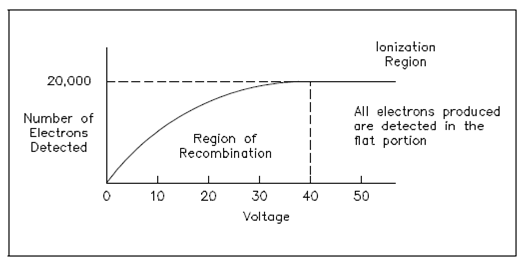Recombination and Ionization Regions:
While the voltage is raised, the free electrons are more powerfully attracted to the positive plate. That will move toward the positive plate more rapidly and will have less opportunity to recombine along with the positive ions. Figure displays a plot of the number of electrons measured through the ammeter as a function of applied voltage.

Figure: Recombination and Ionization Regions
At zero voltage, there is no attraction of electrons among the plates occurs. The electrons would eventually recombine and then there is no current flow. As the applied voltage is raised, the positive plate will start to attract free electrons more powerfully, and a higher percentage will reach the positive plate. As the voltage is increased additional, a point will be reached in that all of the electrons generates in the chamber will reach the positive plate. Any further increase within voltage has no effect on the number of electrons collected.
The simple ionization chamber display in Figure could also be utilized for the detection of gamma rays. Because the ammeter is sensitive just only to electrons, gamma rays must interact along with the atoms in air among the plates to release electrons. Gamma rays interact through compton scattering, photoelectric effect and pair production. Every of these interactions cause a few, or all, of the energy of the incident gamma rays to be converted within the kinetic energy of the ejected electrons. The ejected electrons move at extremely high speeds and cause other electrons to be ejected from their atoms. All of these electrons could be collected through the positively charged plate and measured through the ammeter.